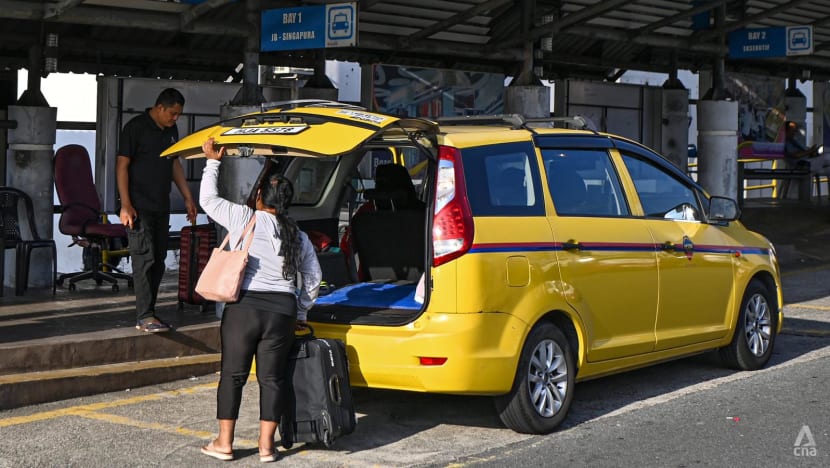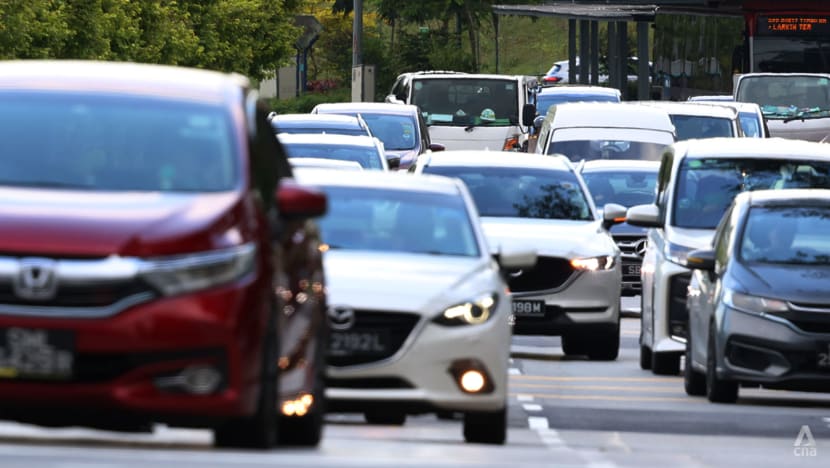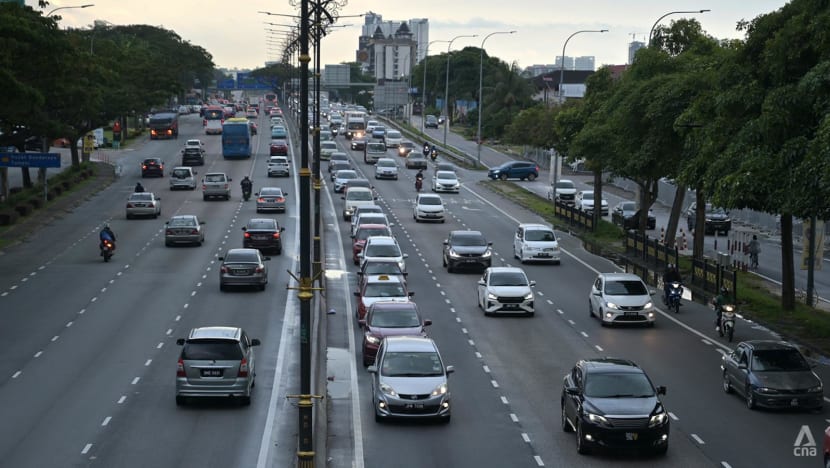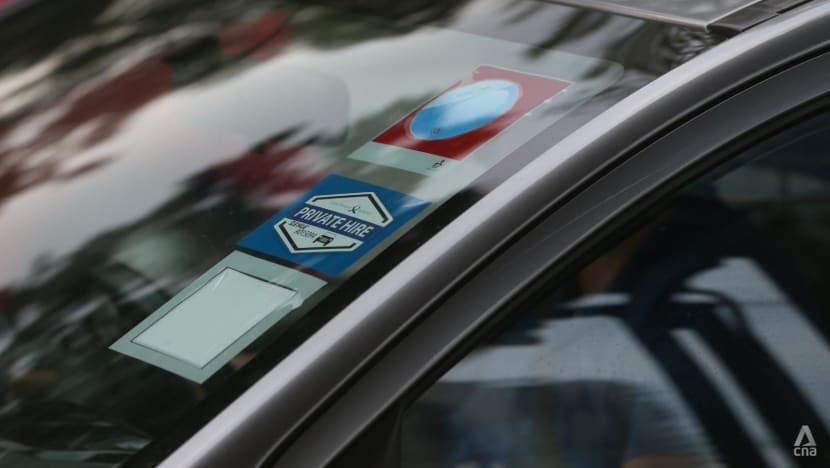analysis Asia
Book a ride via an app to travel between Singapore and Malaysia? Here’s why it’s not yet a reality
Malaysia leaders have called for cross-border ride-hailing with Singapore to become “a reality”, describing it as a “catalyst” in integrating their transport systems. Singapore has said it has no plans to fully liberalise cross-border point-to-point transport via ride-hail services.

A passenger takes a licensed cross-border taxi from Larkin Sentral, Johor Bahru to Ban San Street in Singapore on Aug 6, 2025. (Photo: CNA/Zamzahuri Abas)

This audio is generated by an AI tool.
SINGAPORE: For cross-border ride-hailing services between Malaysia and Singapore to become a reality, a slew of regulatory and cost differences as well as enforcement mechanisms will have to be worked out, say experts and operators.
These include the potential impact on licensed cross-border taxis and the upcoming Rapid Transit System (RTS) Link between Singapore and Johor Bahru, which is set to start operations at the end of next year, they added.
Cross-border ride-hailing services will also have an impact on congestion at land checkpoints, with analysts highlighting that such services will not solve the “fundamental Causeway bottleneck” even as demand for more seamless travel is set to rise with projects such as the Johor-Singapore Special Economic Zone (JSSEZ).
In view of these complex regulatory considerations and hurdles, cross-border ride-hailing services are unlikely to take off soon, analysts told CNA.
Their comments came in the wake of Malaysia Transport Minister Anthony Loke saying on Aug 18 that his country hopes to introduce cross-border ride-hailing with Singapore to increase connectivity. He said it is something both parties must agree on in order to be implemented.
Loke’s response in parliament to Tebrau Member of Parliament Jimmy Puah’s question on cross-border traffic congestion and ride-hailing drivers follows that of Johor Chief Minister Onn Hafiz Ghazi earlier this month.
Onn Hafiz said the issue was among the topics he discussed in a recent meeting with Singapore’s Acting Transport Minister Jeffrey Siow.
Cross-border ride-hailing services would be a “catalyst” for a more user-friendly, safe and competitive transport system while strengthening integration of both countries’ public transport networks, Onn Hafiz said on Facebook on Aug 1.

In response to CNA queries on Loke’s comments, Singapore’s Ministry of Transport said the issue of allowing cross-border ride-hailing was raised when Singaporeans and Malaysian officials met to discuss cross-border service arrangements, but “no decision was made at that point”.
“We are currently reviewing improvements to the Cross-Border Taxi Scheme to address the growing demand for more convenient cross-border point-to-point services,” a ministry spokesperson said.
“It is illegal for Malaysia-registered private cars or private-hire cars to provide cross-border or ride-hail services within Singapore,” the ministry spokesperson added.
Singapore’s Land Transport Authority (LTA) had said on Aug 3 that while it is open to ideas to improve the cross-border commuting experience, “we would like to clarify that LTA has no plans to fully liberalise cross-border point-to-point transport via ride-hail services”.
Instead, it is considering the use of ride-hailing apps to book cross-border trips on licensed taxis and increasing the number of boarding and alighting points in Singapore and Malaysia.
“COMPLEX” AND “DELICATE” ISSUES
Any cross-border ride-hailing model must comply with both countries’ laws, permits and insurance requirements, said Nor Aziati Abdul Hamid, an associate professor and senior researcher at the Universiti Tun Hussein Onn’s Centre of Excellence for Rail Industry in Malaysia.
Drivers’ background checks and training must meet both jurisdictions’ standards, for example, she said.
There will need to be mutual recognition of each other’s private-hire licences, something that does not exist today, said Rosli Azad Khan, managing director MDS Consultancy in Malaysia.
Rules in areas such as transport licensing, insurance, taxation and enforcement must be agreed on, he said.
“Introducing ride-hailing apps to operate cross-border would require bilateral agreements that harmonise these regulatory areas, which is politically and administratively complex,” Rosli said.
Enforcement and dispute resolution mechanisms must also be made clear to address any offences committed by Malaysian drivers in Singapore and vice versa, he said.

In addition, some concerns may weigh more heavily on Singapore, experts told CNA.
There are “significant differences in costs of providing ride-hailing services” in both countries, said Timothy Wong, a senior lecturer at the National University of Singapore’s department of economics.
“Cars are much cheaper to purchase in Malaysia than in Singapore, likewise with petrol and vehicle maintenance costs. The cost of living is also lower in Malaysia so drivers are willing to accept lower wages,” said Wong.
This means Malaysian point-to-point drivers will be able to provide cross-border services at lower prices and thus “dominate the market”, Wong said. “Liberalising the market benefits Malaysian ride-hail drivers more than it does Singaporean ride-hail drivers.”
If such services come to pass, besides agreeing to create a degree of parity in terms of vehicle and driver safety standards, the Singapore government “may also want to introduce price regulations to ensure prices are not too low”, Wong said.
There are “a lot of delicate considerations”, agreed Terence Fan, an assistant professor of strategy and entrepreneurship at the Singapore Management University.
One issue is that once Malaysian ride-hailing services enter Singapore, “it’s much harder to regulate” whether they are also picking up and dropping off people within Singapore, which is not allowed, he said.
“You could potentially be flooding a bit of the Singapore roadways with these vehicles,” Fan told the programme CNA938 Rewind.
“It’s not really in line with our principles here that we have high (Certificates of Entitlement (COEs) for vehicles, we limit the vehicles and we want to make sure our roads are not that congested as well,” he said.
Singapore’s COE system is a key lever in controlling the growth of the vehicle population, according to its Ministry of Transport’s website. Motorists are required to bid for a COE through an online open auction, which gives them the right to own the vehicle for 10 years.
Ride-hailing services also have the potential to add to traffic jams regularly seen at the Causeway, analysts noted.
Unlike buses, trains and the future RTS Link, ride-hailing caters to individual convenience, not mass mobility, said Rosli.
“The big problem is that ride-hailing does not solve the fundamental Causeway bottleneck,” he said. “It may even worsen congestion if thousands of additional e-hailing cars join the daily queue at checkpoints.”
About 300,000 people cross the Causeway daily by vehicle, train or on foot.
Singapore’s Immigration and Checkpoints Authority said in January last year that more than 400,000 people are expected to use the Causeway daily by 2050.

CROSS-BORDER RIDE-HAILING SHOULD “COMPLEMENT” RTS
In spite of the multiple differences that need ironing out and the potential to worsen traffic jams, cross-border ride-hailing can benefit commuters if it is geared towards complementing the Johor-Singapore RTS and rolled out under a phased approach, analysts said.
The service should ideally complement the RTS by serving commuters’ first- and last-mile needs or off-peak journeys, rather than acting as a substitute for the mass transportation network, Nor Aziati said.
The 4km RTS Link, scheduled to begin operations in December next year, aims to ease congestion at the Causeway by ferrying up to 10,000 passengers an hour each way on trips that take about five minutes.
The Singapore authorities would want to “wait” and gauge the public’s response to the RTS when it begins operations, making it unlikely for Singapore to agree to major transport-related policy changes in the meantime, said Fan.
“If you think about it, any Singaporean or traveller from Singapore can just take the RTS to go to Johor Bahru and take a taxi there to get anywhere,” said Fan.
“Once you have a new transport mode like that, it takes time for people to realise, ‘Oh, I can do that. You know, it’s not (as) difficult as I had imagined’,” he said.
Nor Aziati suggested a phased approach to cross-border ride-hailing, starting with an initial pilot area only covering Johor due to “clear demand”, ongoing RTS integration and active state and federal backing.
The initial pilot should only include licensed cross-border taxis that can be booked using apps, and not private-hire vehicles, she said.

This is because introducing large-scale ride-hailing could disrupt the livelihoods of licensed cross-border taxi drivers, she said. A phased integration model, possibly starting with app-based booking of such taxis, may be “a more sustainable first step”.
Under the current cross-border taxi scheme, up to 400 taxis from Singapore and Malaysia are licensed to pick up and drop off passengers only at a single designated point in the other’s country – Larkin Sentral in Johor Bahru for Singapore taxis and Ban San Street Terminal in Singapore for Malaysian taxis.
However, the scheme is underutilised with a total of about 300 licensed cross-border taxi drivers across Singapore and Malaysia as of early August, according to Singapore’s LTA.
A key reason for the under-utilisation is the lack of a door-to-door service, which has made unlicensed taxi services more appealing as they tend to offer flexible pick-up and drop-off points, CNA reported recently.
The authorities clamped down on unlicensed services this month, with drivers caught at Gardens by the Bay, Changi Airport and a land checkpoint in Singapore on Aug 5, and Malaysia’s Road Transport Department detaining and seizing four private-hire vehicles driven by Singaporean individuals on Aug 13.
Licensed cabbies from both sides have expressed concerns about the implications of liberalising ride-hailing and extending cross-border travel to private-hire cars.
Nor Aziati suggested if key indicators for waiting time, safety, number of complaints and price volatility are met for 12 to 18 months under her proposed pilot, the next phase could be to expand it to the Tuas Second Link catchment area.

In response to CNA’s queries, ride-hailing platforms Grab and Ryde said they were open to engaging authorities from both sides.
Providing cross-border ride-hailing services would involve complex regulatory considerations spanning transport policies, safety standards and bilateral arrangements, they said.
Any potential service would require clear guidance and approval from Singapore’s LTA and the relevant Malaysian authorities, said Ryde, which currently only operates in Singapore. “We remain open to engaging constructively with the authorities should a formal regulatory framework be established.”
Grab said it has been engaging both sides’ authorities “to explore safe, legal and equitable solutions” to address the continued demand for cross-border services while reducing reliance on unlicensed operators.
“We stand ready to work with both governments to co-create suitable cross-border ride-hailing services that are safe and convenient for consumers and provide additional earning opportunities for local driver communities in their home country,” Grab said.
The introduction of cross-border ride-hailing in Singapore and Malaysia is not a matter of technical readiness but policy, said Rosli.
“Technically, operators on both sides are ready. The apps, payment systems and logistics may be already in place,” he said.
“What has held it back is not technology but policy – the need for bilateral approval, harmonised regulations and clarity on enforcement.”





















